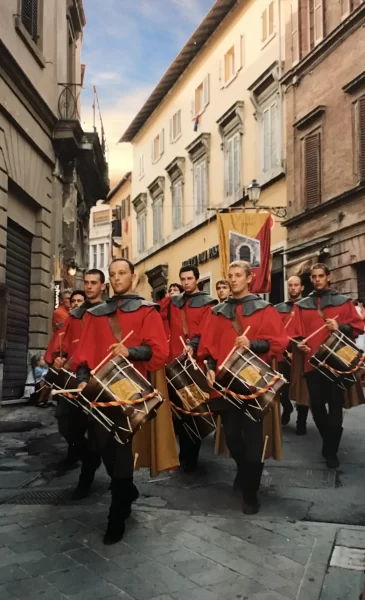#40: Italy, 1997Amerini in Gestation
The town of Amelia, our town, was called Ameria in ancient days, said to be named for its Umbrian founder, King Ameroe. All this is lost in the sands of time, yet the citizens of Amelia are still termed Amerini. Here are excerpts from letters to family about our first summer in our new home. [As always, you can click on photos to enlarge them.]
July 3
It’s been quite a while since I’ve had time to write. As you can imagine, we’ve been awfully busy — Dad’s visit, getting Russell ready to return to Laos, and lots of other stuff too.
My computer’s finally up and running. Well, sort of. I still don’t have English-language programming nor my modem operating, so there’s no email. I can’t yet do anything fancy, because I can’t fully comprehend the directions in Italian. Hopefully, all will be solved next week. But it could be longer.
The night before Dad arrived, we had a horrific rainstorm, and when we awoke the next morning, we had over two inches of mud and water in our living room. The torrential rain had forced the mess through the telephone conduit into the house. Fortunately, we have terra cotta tile floors, so clean-up was tedious but easy. Unfortunately, our beautiful, large Turkoman rug was right in the path of the flood. We’d brought it from Central Asia, where it sang to me when I spotted it in the merchant’s pile. The loss is teaching us not to be hung up on possessions. We’ve got each other, a nice house, three lovely pets and a grand family — that’s what really matters.
We only had time to do partial cleanup before leaving for the airport to meet Dad. So we had to cancel the planned three-day sight-seeing sojourn in Rome and head back home. Dad was a real brick about changing plans on short notice. We spent the next day trying to repair the damage and prevent a recurrence. Our wonderful mason, Vincenzo, constructed a run-off channel for the telephone system. We took the Turkoman rug and another, less damaged one to Terni for cleaning. The less-damaged one turned out OK, but the Turkoman couldn’t be saved — all the brilliant, jewel-like colors had run together.
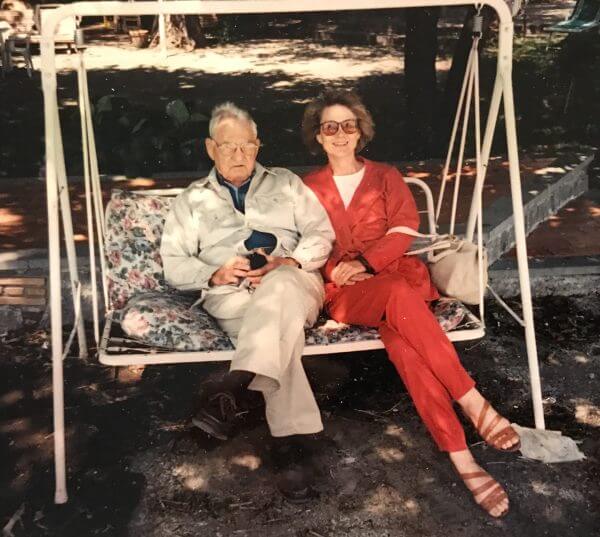 Once we completed these tasks, we headed to Rome for a day, eating a continental breakfast in a restaurant suspended across the freeway. Dad and Russell spent the morning at Villa Giulia, a former pope’s summer retreat, now a museum of Etruscan history which I’d previously toured. I ran postponed errands which would have been accomplished the morning Dad arrived. We had lunch at our favorite restaurant near the Spanish Steps, then visited the Colosseum and the Roman Forum. For me, the most impressive sight was the restored Curia, where the senators met, an austere building, higher than it is wide. Recollecting the historic speeches in that setting gave me a true sense of awe.
Once we completed these tasks, we headed to Rome for a day, eating a continental breakfast in a restaurant suspended across the freeway. Dad and Russell spent the morning at Villa Giulia, a former pope’s summer retreat, now a museum of Etruscan history which I’d previously toured. I ran postponed errands which would have been accomplished the morning Dad arrived. We had lunch at our favorite restaurant near the Spanish Steps, then visited the Colosseum and the Roman Forum. For me, the most impressive sight was the restored Curia, where the senators met, an austere building, higher than it is wide. Recollecting the historic speeches in that setting gave me a true sense of awe.
The next few days were devoted to getting ready for Dad’s 87th birthday party on June 9th. Three days of shopping, cooking, sprucing up house and garden. The prep seemed like it was full of disaster. The oven turned itself off in the middle of baking the cake, eggs got boiled but never deviled, the iron toppled onto the hard tile floor in the midst of ironing the table cloth, guests arrived early, etc. etc. Somehow, it mostly worked out, and what didn’t work out, nobody knew.
People seemed to really enjoy themselves. Henry James wrote that Italians like to please and to be pleased. They enjoy parties, and they revere elders, so they were pleased twice over. They brought Dad lots of gifts — a tie, a typical cheese, plants, grappa — and many of them came with kisses! The party started at 1:00, and the local folks stayed ’til after 6:00. The folks from Rome stayed ’til after dark (and ate up all the boiled eggs, I’m happy to say). At the end of the day, we were tired but happy campers.
The following day was cleanup (neighbor Ornella helping) and packing for departure to Florence and Venice the following morning.
Italy was experiencing a heat-and-humidity wave, so we just had to grin and bear it. We toured Florence’s famous cathedral with its birthday-cake exterior, the Ponte Vecchio lined with jewelry shops as it has been for 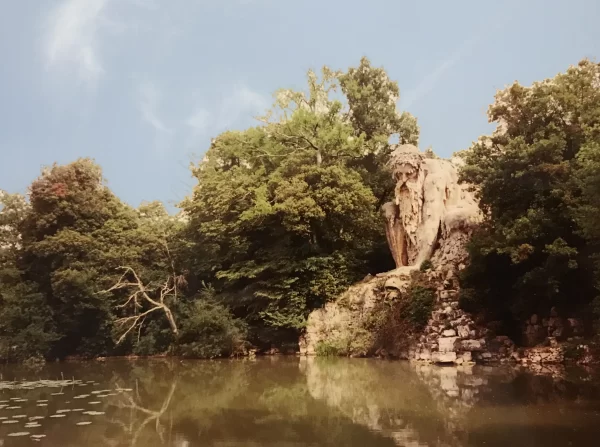 centuries, the Uffizi Gallery full of marvelous paintings, the Palazzo Medici-Riccardi where Lorenzo de’ Medici gave birth, in a sense, to the Renaissance, the Academy Gallery (home of Michelangelo’s David and his four statues of slaves). In between, we managed to eat some mighty fine food, buy presents in an ancient outdoor market and take a buggy-ride through the old city. We also spent a day outside Florence, driving through the countryside to visit Park Demidoff, which surrounds an old summer villa of the nobility. Seeing the colossal statues in the garden made up for not being able to visit the villa.
centuries, the Uffizi Gallery full of marvelous paintings, the Palazzo Medici-Riccardi where Lorenzo de’ Medici gave birth, in a sense, to the Renaissance, the Academy Gallery (home of Michelangelo’s David and his four statues of slaves). In between, we managed to eat some mighty fine food, buy presents in an ancient outdoor market and take a buggy-ride through the old city. We also spent a day outside Florence, driving through the countryside to visit Park Demidoff, which surrounds an old summer villa of the nobility. Seeing the colossal statues in the garden made up for not being able to visit the villa.
On to Venice, where you park your car on the outskirts and ride a boat to a landing near your hotel. It was drizzling when we arrived, so the walk to the hotel wasn’t a thrilling way to meet La Serenissima. Once we got to the hotel — which took only a few minutes — things began to look up. We had reserved an appartamento with Dad’s room downstairs, our room upstairs in a loft, an outdoor terrace with table and chairs, and a two-sink bathroom. Nicely appointed with old furniture, pretty wallpaper and flowers on the terrace. That night, we had dinner in a neighborhood trattoria, a simple restaurant run by a family. That was the beginning of our seafood binge. Except for breakfast (substantial and included in the price of the room), we ate seafood every meal — calamari, sea bass, shrimp, various local fish, clams. If it came out of the sea, we ate it.
The next day, we visited Murano, the island of glassblowers. In 1292, the ruler of Venice decided that the glassblowers (who produced one of the major exports of the city-state) should move to Murano to ensure the safety of the city from fire. After an exhibition of glassblowing at one establishment, we looked at cases and cases of the wares they had for sale — gold-encrusted wine goblets, stark modern vases and everything in-between. We decided to pass on the $100-each champagne glasses, even if they did come in many styles and colors. We then walked along the main canal, looking at colorfully painted houses and shops offering various kinds and qualities of glass items. We found some gifts, and I got a necklace with a glass pendent — informal and inexpensive, my idea of what to buy. We ended up at a restaurant beside the water, where we tucked into more seafood. The vaporetto (sort of a bus on water) brought us back to our landing, its many stops allowing us to see some of the famous sights en route.
The following morning, we took a water taxi (private-hire boat) to Piazza San Marco, where we visited the Doge’s Palace and the Basilica of St. Mark. Fascinating to realize that at one time, the Doge was one of the two most powerful men in the world, the other being the emperor of China. Yet the Doge lived in a few small rooms within the Palace, which housed mostly administrative functions and the prison below. Granted, these rooms were sumptuous, but not palatial in the way we usually mean that term. I much prefer Venice’s Basilica to Florence’s Cathedral. The latter, for me, is too over-done. The design and decor of the Basilica are much older, more Byzantine, full of intricate gold mosaics and dark spaces. The trip back to the hotel via the canals was as fine as any of the sightseeing tours on offer. Passing by the palazzos, catching glimpses up small canals, gliding under bridges, peeking into gardens — just getting around Venice is a treat. We did pass on one excursion we’d planned — gondolas now cost $50 for 30 minutes; this seemed like waterway robbery to us, so we gave it a miss.
Dad was feeling a bit under the weather, so we decided to cut short our Venice visit by one day and take two days to get home. Russell found us a wonderful halfway stop on the Adriatic coast — Portonova, near Ancona, an ancient port founded by the Greeks. En route, we stopped at the Abbey de Pomposa, founded in the 6th century by the Benedictines. We toured the church, full of wonderful old frescos, much simpler and more full of joy than those of the Renaissance.
Portonova is a small spit of land backed by giant cliffs. It’s the site of an 11th century monastery and later of a fort built by Napoleon, now converted to a four-star hotel. We stayed at the three-star down the road and took a drive to see the above sights, as well as a watch tower now converted into a private family home. We had a lovely dinner by the shore, featuring ten different hors d’oeuvres, both hot and cold, all of seafood.
After a good night’s sleep, we drove up and over the Apennines and home. The drive through the mountains was one of the highlights of the trip. Up, up we went on a narrow, winding road until we came to a succession of high alpine meadows full of red poppies. The air was cool and clean, a real treat after the heat and humidity of the previous days.
Before Dad departed for the States, we took one more trip, this time to Terni’s Cascata delle Marmore, a waterfall constructed in 270 BC by the Romans to drain the marshes around Rieti. It’s a spectacular sight — 165 meters in three drops down marble cliffs. Nowadays, it can only be seen during the weekends, because the water has been diverted to create electric power during the week. Mind-boggling to consider that it was built so long ago, that so many famous travelers had written of it, and that it’s still in use, not only to drain marshes, but to generate hydropower.
After Dad left, we spent the rest of the week getting Russell ready to fly to Laos — wrapping presents, selecting wardrobe, washing, ironing, sewing on buttons, etc. Faxes were flying fast and furious back and forth from the Hawaiian firm that hired Russell to head up the project. We went down to Rome on Friday to collect R’s Thai Air ticket. When we got back home, there was a fax waiting with the message to move his trip forward one day. This was rescinded a few hours later, so we were spared that hassle.
The night before Russell left, we drove to the nearby town of Guardia to hear a performance by the Amelia chorale. They have grand voices, a good blend, and work very hard three nights a week to prepare demanding music to a high standard. A nice way to end Russell’s hiatus here.
August 1
Russell’s much-postponed two-week trip to Laos was very productive. He returned on July 13 and spent the next eight days writing the final report, sent off by DHL. Now he’s busy with farm work — clearing brush with our new “bushwhacker” and sawing into firewood the dead branches that I’d cut off fruit and nut trees. We’ve decided a chain-saw will be our next equipment purchase.
While R was gone, I finished revising the first three chapters of my mystery novel set in Laos. Hoping to finish by the end of the year.
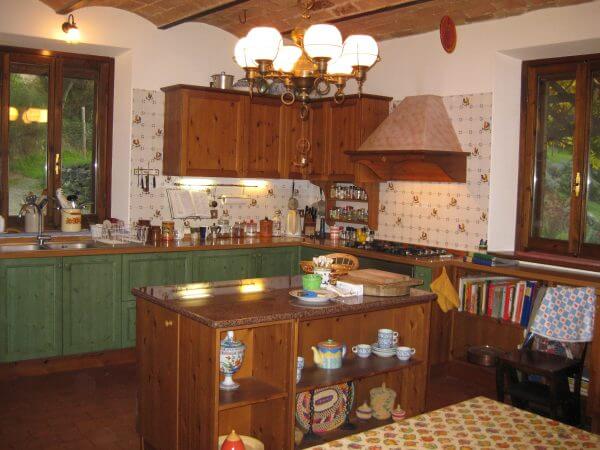 We’ve managed lots of household projects with professional help — upholsterer, electrician, mason. Making the biggest difference was my finding, and the electrician installing, the perfect light above the kitchen island. The new brackets with hanging baskets of geraniums on either side of the front door are pretty spiffy too.
We’ve managed lots of household projects with professional help — upholsterer, electrician, mason. Making the biggest difference was my finding, and the electrician installing, the perfect light above the kitchen island. The new brackets with hanging baskets of geraniums on either side of the front door are pretty spiffy too.
Toward the end of the month, one of R’s law school classmates and wife came to visit. So we took time off chores to visit Todi and Orvieto, famous hill towns nearby. Our next set of company arrives Aug. 10th, and we’re hoping to finish the interiors of the closets — painting the ceilings and installing shelves over the bars — before they arrive. We’ve also got guests coming in September and October, so we’re on the circuit!
August 16
The farmer harvested his oats in the next field, and the shepherd brought his sheep to glean whatever grains might be left. Then the farmer returned and plowed the field, so he’s ready to plant his second crop this year.
Our fruit is ripening on the trees — peaches, pear-shaped yellow plums, sour green apples. We added raisins and chopped onions to the latter two and ended up with some pretty fair chutney.
This is the time of summer festivals in all the local towns. We have a ringside seat for the towns’ fireworks on the other side of the valley. Italians are considered the best fireworks manufacturers in the world. Some effects were new to me; e.g., a huge star within a circle which then exploded into a fountain of sparks. After one display, a real shooting star fell across the sky — a spectacular combination of man and nature.
Amelia’s celebration lasts two weeks. The weekend of the 8th featured events commemorating the city’s medieval period. On Friday evening, we joined friends Giuseppina and Alberto (she sings in the chorale I mentioned). First, we had homemade ice cream and toured their “new” house in the historic center. They’d joined two old, small structures into a creative house within a walled garden. The smaller building became a large kitchen, pantry and powder room. A wide hallway with sliding glass doors to the exterior connects these rooms to the larger structure. This section has a living room on the ground floor, two children’s rooms on the second floor and the master bedroom suite up under the old attic eaves. Giusy fought City Hall until she finally got clearance to cut away part of the roof to make an enclosed terrace up there, allowing light to come into their bedroom and bath, along with a view of the cathedral and medieval tower. The terrace can’t be seen from the street, so the historic cityscape is preserved.
Afterwards, we walked down to the Via Repubblica (constructed over an ancient Roman street) to watch the yearly procession. During the Middle Ages, Amelia was divided into five neighborhoods, each with its own colors, emblem, etc. Now every year during the summer festival, the residents of each neighborhood parade in medieval costume. Then the huge, ancient gates of the Porta Romana are closed for the only time during the year, followed by a ceremony of giving the key to a dignitary who then re-opens them. It’s a very solemn occasion, and the drum beats, intricate and in at least three parts, reflect that. The costumes are authentic, including boots, coiffures, headgear, etc. Each neighborhood’s contingent is preceded by its banner and drummers. Then come “soldiers” and townspeople of all classes — noblemen, merchants, poor folk, religious orders — followed by the highest-ranking man in an elaborate costume and then more “soldiers.” A moving, live re-creation of history. We wouldn’t have missed it for the world.
Saturday’s event was a “medieval field day” with tournaments in crossbow and jousting. Five middle-aged men in simple costumes of earth colors competed in the crossbow, shooting at small targets 100 meters away. It seemed very difficult. The bows are taller than most men and must be wound with a heavy tool. Then the bows are placed on a support system with a seat from which the man fires the bolt. The competitors were exceedingly skilled and hit a lot of bullseyes.
While the crossbow competition was going on in the middle of the field, young men on horseback with lances competed in twos to hit a suspended target. Their horses were particularly beautiful and well-trained. The two competitors, each dressed in the colors of his neighborhood, start on one side of the ring behind gates. Suddenly the gates are thrown open, and the horses explode around the ring in opposite directions as the riders ready their lances. On the far side is the target. The first man to hit it wins. The crowd screams for their favorites, and it’s all very exciting.
At the end of these competitions, the judges announced not only who had won the jousting and crossbow tournaments, but also which neighborhood’s drummers had won and which neighborhood’s and individual’s costumes had won from the previous night. Bragging rights last all year.
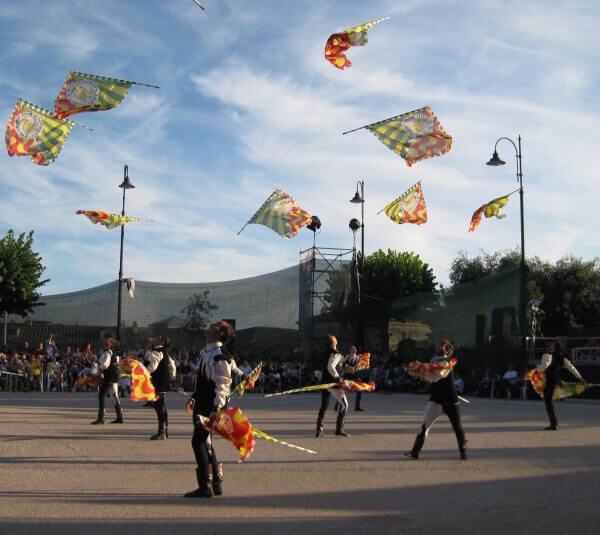
Photo taken during a later Amelia-hosted competition. Not of the Amelia team, but my best shot of this wonderful spectacle.
Sunday hosted an exhibition of what I can only call flagmanship, but that term doesn’t do it justice. Young men dressed in heraldic tights and tabards put on an exhibition with colorful banners, throwing them high into the air, often to another team member, catching them, twirling them in intricate patterns. It was extremely athletic and graceful. They did this in groups of eight, six, four and two, as well as a couple of individuals who were exceptionally talented. The youngest were about six years of age, while the oldest (and most skilled) were well into their twenties/early thirties. They performed in the square outside the walls of the old city. We watched from the walls, and some of the flags were thrown up to our level — three or four stories! The flag staffs are weighted, so they always fall to earth with the handle-end downward. As they fall, the banners unfurl into intricate designs. These displays take year-round practice of incredible skill and dexterity.
As we attended the events of this annual festival, including each neighborhood’s taverna with food cooked by the women who live there, I felt us becoming part of Amelia and Amelia becoming part of us

COMING NEXT MONTH
Italy, 1997
In the midst of life, we are in death

LET ME HEAR FROM YOU.
Please take a moment to share your thoughts.
Your comments help make the blog better, and I always answer.
* * *
If you enjoyed reading this post, I hope you’ll SUBSCRIBE by clicking on the button below. Every month, when I post a new excerpt from my life overseas, you’ll get an email with a link so you can read the next installment. Subscription is free, and I won’t share your contact information with anyone else. Your subscribing lets me know you’re reading what I write, and that means a lot.

